-
收藏模板
- 模板信息
- 更新时间:2023-09-09
- 字数:约56144字
- 页数:约38页
- 格式:.doc
- 推荐版本:Office2016及以上版本
- 售价:5 金币
您可能喜欢的文档
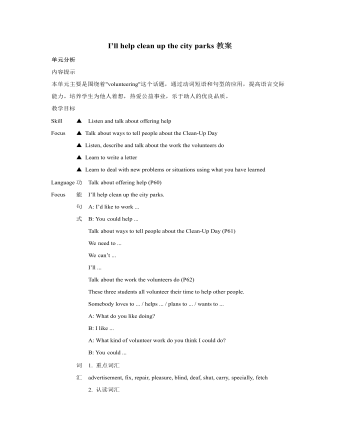
人教版新目标初中英语九年级下册I’ll help clean up the city parks教案
Talk about offering help (P60)I’ll help clean up the city parks.A: I’d like to work ...B: You could help ...Talk about ways to tell people about the Clean-Up Day (P61)We need to ...We can’t ...I’ll ...Talk about the work the volunteers do (P62)These three students all volunteer their time to help other people.Somebody loves to ... / helps ... / plans to ... / wants to ...A: What do you like doing?B: I like ... A: What kind of volunteer work do you think I could do?B: You could ...1. 重点词汇advertisement, fix, repair, pleasure, blind, deaf, shut, carry, specially, fetch2. 认读词汇hunger, homeless, cheer, clean-up, sign, establish, major, commitment, elementary, veterinarian, coach, similar, call-in, strategy, disabled, organization, unable, support, appreciate, donation, part of speech, pronoun, adverb, preposition, conjunction, donate, Jimmy, Sally3. 词组clean up, cheer up, give out, put off, set up, think up, take after, fix up, give away, put up, hand out, work out, at once

人教版新目标初中英语九年级下册I’ll help clean up the city parks说课稿5篇
二、教法学法1、任务型教学法:每个教学环节都是围绕着如何完成一个教学任务来设计的。2、感悟法:创设语境,让学生在一定的语言环境中感悟语言内涵,从而实现悟中学的目的。只有学生自己悟出的东西才能较好地内化为自己的东西。3、合作点拨法:通过教师创设的学习氛围,设置问题和反思质疑,推动师生,生生间的合作探究,小组合作学习,在解决问题中完成教学目标。以培养他们的合作探究的意识与精神。三、教学程序1 导入新课利用课件中的图片导入:在大屏幕上出示汶川大地震中一些悲惨的图片,让同学们说出汶川,然后老师说as well-know a stong earthquake happened in wenchuan,so many kind people go there to help others.再出示一些军人,医疗工作者,志愿者忙碌的身影,特别是温家宝总理看望受伤的孩子,让同学们知道一方有难,四方支持,帮助困难中的人是很有意义的。然后说Would you like to help others?What would you like to do?
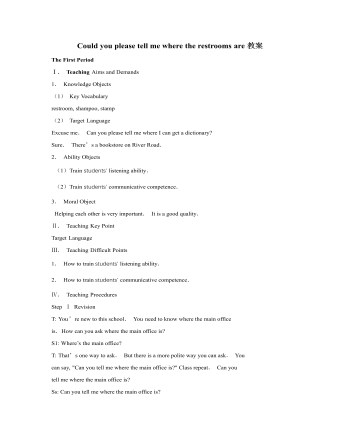
人教版新目标初中英语九年级下册Could you please tell me where the restrooms are教案
Step Ⅰ RevisionCheck homework. Ask a few students to read the article in 3a.Then ask a few students to read their guides.Step Ⅱ Part 1Look at the words in the box. Ask a student to read them. Make sure the students understand the meaning of the words. You are to fill in the blanks with the words. In some cases, students may need to use another form of the word, for example adjusting for tense or subject/ verb agreement.Ask students to fill in the blanks on their own.Check the answers. Step ⅢPart 2Go through the instructions with the class.Look at the example with the students.Ask students what the answer would be.Ask a student to read the question and answer it.Excuse me, could you tell me where the bank is, please?The bank is across the street from the shopping malt.Get students to complete the work in pairs.Check the answers. Ask a few students to read their questions.Step Ⅳ Just for Fun!Ask all the students to read the conversation. Ask: What is funny about this cartoon? Help students to explain. A Martian is a person from the planet Mars.There is no such thing as Martian food on Earth, and the clerk looks silly because he is trying to think of where there is a Martian restaurant.Invite some pairs of students to present this conversation to the rest of the class.Step Ⅴ Summary and HomeworkIn this class, we’ve done much writing practice using the key vocabulary words and the target language presented in this unit. After class, please finish the questions in 2 in your exercise books. Then finish the exercises on pages 47~48 of the workbook as well.The Seventh Period Ⅰ Teaching Aims and Demands1. Knowledge Objects(1) Key Vocabularyimage, adventure, jealousy, hero, crime, journey, brave, no longer, show interest in, take it easy, become interested in, plain looks(2)Text:Grown-ups like cartoons, too.2. Ability Objects(1) Fast-reading to get a general idea of the text.(2) Careful-reading to get the detailed information in the text.
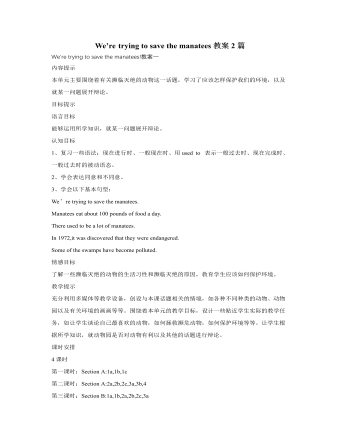
人教版新目标初中英语九年级下册We’re trying to save the manatees教案2篇
本单元主要围绕着有关濒临灭绝的动物这一话题,学习了应该怎样保护我们的环境,以及就某一问题展开辩论。目标提示语言目标能够运用所学知识,就某一问题展开辩论。认知目标1、复习一些语法:现在进行时、一般现在时、用used to 表示一般过去时、现在完成时、一般过去时的被动语态。2、学会表达同意和不同意。3、学会以下基本句型:We’re trying to save the manatees.Manatees eat about 100 pounds of food a day.There used to be a lot of manatees.In 1972,it was discovered that they were endangered.Some of the swamps have become polluted.情感目标了解一些濒临灭绝的动物的生活习性和濒临灭绝的原因,教育学生应该如何保护环境。教学提示充分利用多媒体等教学设备,创设与本课话题相关的情境,如各种不同种类的动物、动物园以及有关环境的画画等等。围绕着本单元的教学目标,设计一些贴近学生实际的教学任务,如让学生谈论自己最喜欢的动物,如何拯救濒危动物,如何保护环境等等。让学生根据所学知识,就动物园是否对动物有利以及其他的话题进行辩论。
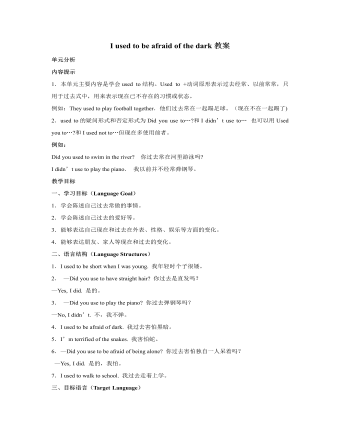
人教版新目标初中英语九年级上册I used to be afraid of the dark教案
内容提示1.本单元主要内容是学会used to结构。Used to +动词原形表示过去经常、以前常常,只用于过去式中,用来表示现在已不存在的习惯或状态。例如:They used to play football together.他们过去常在一起蹋足球。(现在不在一起踢了)2.used to的疑问形式和否定形式为Did you use to…?和I didn’t use to… 也可以用Used you to…?和I used not to…但现在多使用前者。例如:Did you used to swim in the river? 你过去常在河里游泳吗?I didn’t use to play the piano. 我以前并不经常弹钢琴。教学目标一、学习目标(Language Goal) 1.学会陈述自己过去常做的事情。2.学会陈述自己过去的爱好等。3.能够表达自己现在和过去在外表、性格、娱乐等方面的变化。4.能够表达朋友、家人等现在和过去的变化。二、语言结构(Language Structures) 1.I used to be short when I was young. 我年轻时个子很矮。 2. —Did you use to have straight hair? 你过去是直发吗?—Yes, I did. 是的。 3. —Did you use to play the piano? 你过去弹钢琴吗?—No, I didn’t. 不,我不弹。 4.I used to be afraid of dark. 我过去害怕黑暗。 5.I’m terrified of the snakes. 我害怕蛇。
- 查看更多相关Word文档
By the time I got outside, the bus had already left教案
The First Period
Ⅰ. Teaching Aims and Demands
1. Knowledge Objects
(1) Key Vocabulary
oversleep
(2) Target Language

What happened?
I overslept. And by the time I got up, mybrother had already gotten in the shower.
2. Ability Objects
(1) Teach the students to use the new words.
(2) Train the students to narrate past events with the Past PerfectTense.
(3) Train the students listening and speaking skills with the targetlanguage.
3. Moral Object
It’s a good habit to go to bedearly in the evening and get up early in the morning. So you’ll never be in a hurryin the morning.
Ⅱ. Teaching Key Points
1. Key Vocabulary
oversleep
2. Target Language
Narrate past events with the Past PerfectTense
Ⅲ. Teaching Difficult Points
1. Train the students to narrate past events with thePast Perfect Tense.
2. Train the students to understand the targetlanguage in spoken conversation.
Ⅳ. Teaching Methods
1. Thinking of examples from the students real lives.
2. Making sentences by looking at the pictures.
Ⅴ. Teaching Aid
A tape recorder
Ⅵ. Teaching Procedures
Step I Revision
1. Revise the language points in Unit 8.
Ask some questions like this: What volunteerwork would you like to do?
Help the students to answer, I’d like to…/I love to…/I hope to
2. Practice the dialogue in Activity 3c on page 62again. Getstudents to role play the similar dialogues with the following.
SA: I’d like to join the schoolvolunteer project, but I’m not sure what I should do.
SB: What do you like doing?
SA: I love playing football.
SB: Well, you could help coach afootball team for little kids. Let the children practice in pairs.
3. Check the students homework by asking somestudents to read their sentences with the phrasal verbs. Then ask the students to handin their homework.
4. Dictate the following words:
clean up, cheer up, give out, put off, set up,run out of, take after, fix up, give
away, call up, hand out, work out, hunger,establish, commitment, veterinarian, strategy
Step Ⅱ 1a
This activity introduces newvocabulary which can be used to narrate past events.
First write by the time on theblackboard. and tell the class the meaning of it.
"by the time" meansnot later than, before, as soon as, or when the indicated comes. When we use the words. "By the time…, "we are talking abouttwo different things that happened in the past. Say this sentence to the class: By the time theteacher came in, the students had begun reading English.
Tell them to note the struture"had begun" in this sentence. Begun is the past participle of begin. When we talk about two eventsboth happened in the past, the one which happened earlier should use and plus apast participle. The words following By the time…, talk about the thing that happened later. And tell the students whenthey use had plus a past participle, they are using the Past Perfect Tense. Also explain what is the pastparticiple form of a verb for the students. Tell them it is as the same as the past form for aregular verb. And they have to remember the irregular verbs’ participles one byone.
Play a game to help thestudents understand the sentences with the words By the time…Do it like this:
Pretend that the teacher willleave the classroom and the students will do some things. When the teacher returns. the class will make statementsstarting with By the time
Write By the time I came back…on the blackboard.
Say to the class, By the time Icame in. whathad happened?
Help one student to answer likethis, By the time the teacher came in, Don had written his name on theblackboard.
Then get more students toanswer differently, such as,
By the lime the teacher camein, we had discussed an English problem.
By the time the teacher camein, I had drawn a picture.
Write these sentences on theblackboard, and teach the students to read several times.
Read the instructions to thestudents and read these questions to the class as well.
What do you usually do in, themorning before school? Do you like morning?
Why or why not?
Choose one good student toanswer them by saying something he or she usually does in the morning.
He or she may answer like this,
I usually get up early, wash myface and have breakfast. I like mornings because the air is fresh, or I usually get up aslate as possible. Then I have to wash my face and have breakfast in a hurry. I often rush to school withoutbreakfast. Sometimes I forget something at home. I don’t like mornings becauseI am always too busy.
Then have the whole classpractice in pairs. Ask each other the questions.
After they finish talking, askone or two pairs to say their conversations to the class. Correct the mistakes they maymake with the other students.
Call the students attention tothe pictures in Activity la. Ask students to tell what they see.
Say, Any sentences which makesense are accepted to describe the pictures.
The girl in the pictures isTina.Present the new words by providing sentences showing the meanings of them likethis:
T: What can you see in Picture1?
S1: She slept a longtime.
T: That’s correct. She slept too late. She overslept. Class repeat. She overslept.
Ss: She overslept.
T: What do you see in Picture2?
S2: Her brother orsister is in the bathroom.
T: That’s correct. She wants to go into thebathroom. Shecan’t because someone is taking a shower. Class repeat. Someone is taking a shower.
Ss: Someone istaking a shower.
Write these words on theblackboard:
overslept, taking a shower, hadleft, left her backpack at home.
Then tell students to talkabout the pictures in groups of four. Move around the classroom, listening to studentsand offering help. Make sure that they talk in English.
After they all finish talking,ask different groups to tell the class about the pictures. They may say like this:
Tina overslept in the morning. She wanted to go to thebathroom, but her brother had already gotten in the shower. When she got to the bus stop,the bus had already left.
She had to run to school. After she got to school, sherealized she had left her backpack at home. The sentences can vary, but should be correct.
Step Ⅲ 1b
This activity gives studentspractice in understanding the target language in spoken conversation.
Ask the students to read theinstructions together. Have them look at the two columns, A and B ,in the chart. Point out the sample answer. Read the two parts of thesentence.
Then go over the otherunconnected parts of sentences, too.
You will connect the two partsof the sentences, connect a sentence beginning in the first column with the endof that sentence in the second column. Please guess the other two sentences before I playthe tape.
I guess most of the childrencan get the correct sentences by guessing. So just let them guess. Don’t tell them whether theiranswers are right or wrong.
OK, just keep your answers byguessing.
Let’s decide if they are rightby listening to the tape now.
Play the recording for thefirst time.
Students only listen. Then play it a second time. Let students match two partsof each sentence. Check the answers by asking some students to tell their answers.
Make sure that all of them havegot the correct answers by listening. Say congratulations to the students who get theanswers correctly by guessing.
Answers
1. b 2. a 3. c
Tape script
Boy: Hi, Tina. You look stressed out.
Girl: I am. I had a bad morning.
Boy: Really? What happened?
Girl: Well, first of all Ioverslept. By the time I got up, my brother had already gotten in the shower.
Boy: Oh, what a pain!
Girl: So, after he got out ofshower, I took a quick shower and got dressed. But by the time I went outside, the bus had alreadyleft.
Boy: Oh, no!
Girl: Oh, yes! So I ran all theway to school. But when I got to school, I realized I had left my backpack athome.
Boy: No wonder you lookstressed out.
Step Ⅳ 1c
This practice provides guidedoral practice using the target language.
First play the recording inActivity 1b
again and let the students readafter it. Do itat least twice.
Then read the instructionstogether with the whole class.
You will make conversations inpairs. Eachof you will have to take turns being Tina. Look at the pictures in Activity la to help you. Tell your partner whathappened to you this morning. Ask a pair to read the example to the class before they beg it
SA: What happened?
SB: I overslept. And by the time I got up, mybrother had already gotten in the shower.
Write the conversation on theblackboard.
Have the students work in pairs. Move around the room offeringlanguage support as needed.
After they all finish talking,ask some pairs to say their conversations to the class.
Step Ⅴ Summary
Say, In this class, we’velearned how to narrate past events, using the Past Perfect
Tense. We’ve also done some listeningpractice in understanding the target language in spoken conversation. Also, we’ve done much oralpractice using the target language.
Step Ⅵ Homework
1. Write out the story of Tina, Note to use the targetlanguage.
2. Revise when to use the Past Perfect Tense and theverb structure of it.
Step Ⅶ Blackboard Design
By the time I got outside, the bus had already left. Section A The First Period 1. By the time By the time the teacher came in, the students had begun reading. By the time the teacher came in, Don had written his name on the blackboard. By the time the teacher came m, we had discussed an English problem. 2. Some words to describe the pictures overslept, taking a shower, had left, left her backpack at home. 3. Target Language: A: What happened? B:I overslept. And by the time I got up, my brother had already gotten in the shower. |
By the time I got outside, the bus had alreadyleft.
The Second Period
Ⅰ. Teaching Aims and Demands
1. Knowledge Objects
(1) Target Language
By the time she got to class, the teacher hadalready started teaching.
When she got to school, she realized she hadleft her backpack at home.
When I got home, I realized I had left my keysin the backpack.
(2)The Three Forms of the verbs.
2. Ability Objects
(1) Train the students listening skill.
(2) Train the students writing skill with the target language.
(3) Train the students speaking skill.
(4) Train the students to use the three forms of the verbs.
3. Moral Object
Try to be a careful person anddo everything carefully. Remember not to be as careless as Tina.
Ⅱ. Teaching Key Points
1. Listening practice with the target language.
2. Use the correct verb forms to fill in the blanks bylistening.
3. Make sentences using the Past Perfect Tense.
4. The three forms of the verbs.
Ⅲ. Teaching Difficult Points
1. Write an ending for the story in Activity 2c.
2. The three verb forms in Grammar Focus.
Ⅳ. Teaching Methods
1. Listening
2. Pairwork
Ⅴ. Teaching Aids
A tape recorder
Ⅵ. Teaching Procedures
Step I Revision
1. Revise what happened to Tina in the morning byasking one or two students to tell the stroy on page 68.
They may say like this:
Tina had a bad morning. First of all she overslept. By the time she got up, herbrother had already gotten in the shower.
And by the time she wentoutside, the bus had already left. She had to run all the way to school. When she got to school, sherealized she had left her backpack at home. All these made her look stressed out. After that, ask the wholeclass to work in pairs, telling the stroy and helping each other in turns. Remind them to use the correctverb forms.
2. Ask students to check each other’s homework inpairs, pointing out all the mistakes they might have made.
3. Revise the Past Perfect Tense by asking thechildren when to use it and what its verb structure is.
Step Ⅱ 2a
This activity provides guidedlistening practice using the target language.
We have known Tina had a badmorning.
But something worse happened toTina later. Let’s go to Activity 2a on page 69 and see what happened to Tinalater in the morning.
Read the instructions to theclass. Besure that all of them know what to do.
Call the students attention tothe four pictures. Get them to guess the correct order of the pictures first. The first one is given as asample. Askone or two children to tell their stories by describing the pictures accordingto their own order.
Then, we will hear Tina talkingabout what happened to her after she got to school. We can see there is a smallbox in each picture.
Please write a number from 1 to4 in each box to show each picture’s correct order.
The first one has been given asa sample.
Get the children to get readyto listen to Tina continue her story.
Play the recording the firsttime, students only listen. Play the recording again and ask the children to number eachpicture.
Check the answers with theclass and see who have ever got the correct answers without listening.
Answers
The pictures should be numberedin this order:
3 1 2 4
Tape script
Boy: So then what did you do,Tina?
Girl: Well, I ran home to getmy backpack.
But when I got home, I realizedI had left my keys in the backpack.
Boy: You’re kidding!
Girl: So I ran back to schoolwithout my keys or my backpack. And by the time I got back to school, the bell had rung.
Boy: Oh, no!
Girl: And by the time I walkedinto class, the teacher had started teaching already. She asked for our homework,but of course I didn’t have it.
Step Ⅲ 2b
This activity gives studentspractice in understanding and writing the target language.
Ask the students to read theinstructions together. Point out the blanks in the sentences and the verbs in thebrackets.
This activity has two parts. First let’s fill in the blankswith the correct verb forms. We can see some verbs in the brackets. They are the base forms of thegiven verbs. For example, get and got, Get is the base form of the verb. Your job is to write thecorrect forms of these verbs in the blanks. Look at number one.
A sample answer is given.
Let the students fill in theblanks with the correct forms individually.
Move around the classroomcollecting the common mistakes they may make.
After they all finish writing,tell them to get ready to listen to the conversation and check their answers.
I will play the recording again. Please check your answers andcorrect any mistakes you might have made while listening. Play the recording. Students listen and checktheir answers. Correct the answers by asking seven different students to saytheirs to the class.
Answers
1. got home 2. realized 3. had left
4. got 5. had rung 6. walked 7. had started
Step Ⅳ 2c
This activity gives studentsoral practice with the target language.
Ask the whole class to read theinstructions together.
We have a new task now. We know Tina was late forclass. Whatdo you think happened after Tina was late for class?
Work with a partner. Make up an ending for the storyby continuing it. The beginning has been given.
Get students to discuss inpairs.Complete the ending. Make sure they are talking in English. Move around the classroom,offering language support if needed. After ten minutes, ask students to stop discussing. Get some pairs of students totell the class how they think the story ended And let the whole class decidewhose ending is the best. Tell each pair to write down their ending, or do it after classif time is not enough.
Sample ending of the story
The teacher looked at Tina andsaid, " Why are you late and where is your homework, Tina?" "Ihad a bad morning today. " Tina said sadly.
"I’m sorry to hear that,but may I know what happened? said the teacher.
Then Tina told the teacher andthe whole class her story. All her classmates laughed loudly after it. Some of them said, "PoorTina!"
Bob, one of Tina’s classmates,stood up and said, "Well, Tina, I’d love to help you. Why not let me keep the keysfor you? I would put your keys in my backpack."
Step Ⅴ Grammar Focus
This activity introduces thetarget language of this unit. Call students attention to the sentences on the left. Ask four different students toread the four sentences and point out where had plus a past participle is used. Write the sentences on theblackboard.
Draw a simple time line foreach sentence to help students to understand the grammar focus. For example:

Then get the students to lookat the box.
Teach students to read thethree forms of each verbs first. Then ask several students to read the verbs to the class to seeif they can read. Write the verbs on the blackboard.
Ask the students to makesentences correctly using each form of the verbs in the box. For example:
I usually get up at 6:30.
I got up at 5:30 yesterday.
By the time I got up, my sisterhad already gotten in the shower.
Tell the students when we talkabout the first thing that happened. We use had plus a past participle (had gotten) and when we talk about thesecond thing that happened, we use the simple past tense (got up). Ask some to read theirsentences to the class.
Ask the students to make theirown lists of other verbs used in this unit. Tell them to put the lists in their notebooks usinga three-column format like the one in the Look! section. The lists have to includethese verbs; leave, walk, start, oversleep, ring, be.
Check the answers.
Some sample sentences with thethree verb forms
1. I got up at 6:30 every day.
I got up at 6:00 yesterday.
By the time I got up, my sister had alreadygotten in the shower.
2. We usually go to school at 7:30.
We went to school at 8:30yesterday.
By the time we got to theclassroom,
the students had gone to thechemistry lab.
3. My father leaves home at 8:30.
He left home at 9:30 thismorning.
When my father went outside,the bus had left.
4. The teacher often starts teaching at 9:00.
The teacher started teaching at 8:30 the daybefore yesterday.
When Tina got to class, the teacher hadalready started teaching.
The three forms of the verbs used in thisunit:
Leave left left
Walk walked walked
start started started
oversleep overslept overslept
ring rang rung
Be was/were been
Step Ⅵ Summary
Say, In this class, we’ve donemuch listening and writing practice with target language. We’ve also done some oralpractice in pairs. And we’ve discussed the Grammar Focus of this unit.
Step Ⅶ Homework
1. Write down the ending of Tina’s story.
2. Make sentences using each form of the verbs below:
leave, walk, start, oversleep,ring, be
3. Review the Grammar Focus.
Step Ⅷ Blackboard Design
By the time I got outside, the bus had already left. Section A The Second Period Target Language: 1. By the time she got up, her brother had already gone into the bathroom. 2. By the time she went outside, the bus had already gone. 3. By the time she got to class, the teacher had already started teaching. 4. When she got to school, she realized she had left her backpack at home. Verbs: Get got gotten Go went gone Leave left left Start started started |
By the time I got outside, the bus had alreadyleft.
The Third Period
Ⅰ. Teaching Aims and Demands
1. Knowledge Objects
(1) Key Vocabulary
bell, ring, go off, rush, runoff, on time, give sb. a ride, lock, break down
(2) Target Language
By the time I got there, the bus had alreadyleft.
By the time I woke up, my father had alreadygone into the bathroom.
2. Ability Objects
Train the students reading skill with targetlanguage.
Train the students speaking skill with targetlanguage.
3. Moral Object
Have you ever done anything carelessly?
Share your story with your friends.
Ⅱ. Teaching Key Points
1. Guide the students to read the article in activity3a.
2. Help the students do the oral practice with thetarget language.
Ⅲ. Teaching Difficult Points
1. Help improve the students reading skill byActivity 3a.
2. Help the students describe what has happened tothem with the target language.
Ⅳ. Teaching Methods
1. Get the main idea by reading.
2. Pairwork.
Ⅴ. Teaching Aid
A projector
Ⅵ. Teaching Procedures
Step Ⅰ Revision
1. Revise what happened to Tina by asking several studentsto tell the story.
2. Revise the three forms of the verbs in GrammarFocus by asking four students to write them out on the blackboard.
3. Check homework by asking one or two to read theirown endings of the stroy.
4. Check homework by asking some students to read thesentences which they made.
5. Ask the students to hand in their homework.
Some sample sentences with theverbs used in this unit:
1. I leave home at 7:30 every morning.
I left home at 8:00 thismorning.
By the time I got to the airport,the plane had left.
2. I walk to school sometimes.
I walked to school yesterday afternoon.
When I got there, the sick girl had walk away.
3. The meeting start at 3:00 every Wednesday afternoon.
The meeting started at 3: 30 last Wednesdayafternoon.
As soon as Mr. Jones got to the meeting room, the meeting hadalready started.
4. Tina seldom oversleeps.
Tina overslept this morning.
Tina said she had never overslept before.
5. The hell rings at 8:10 every morning.
The bell rang at 7:10 this morning.
When I got to school, the first bell had rung.
6. I am here now.
I was at home last night.
I had been here for 20 years by the end of2003.
Step Ⅱ 3a
This activity provides readingand writing practice using the target language.
Show the vocabulary on thescreen by a project:
bell n.钟;铃 ring v.鸣;响 go off 闹钟(闹响) rush v.冲;奔 rush off 跑掉;迅速离开 on time 准时 give sb. a ride让某人搭便车 lock v.锁;锁上 break down 损坏;坏掉 |
Point to the words one by oneand teach the students to read them. Do it several times. Then ask several students to read the words to seeif they can pronounce each word correctly.
Ask the whole class to read theinstructions together. There is an article in Activity 3a. Your task is to read the story and write the eventsin the correct order.
Have a look at the sampleanswer on the right of the article before you start. Then let the children completethe work on their own. After a while, ask some students to report their answers to theclass. Writethe events on the blackboard as they report, putting the events in the correctorder.
After checking the answers,tell students to read the article again more carefully.
Tell them to find out the wordsor sentences which they can’t understand this time.
A few minutes later, let thestudents ask questions on the words and sentences which they can’t understand. Do some explanation and makesure that the students make everything clear about the article.
Then ask the students to readthe article aloud. Move around the classroom while they are reading, offering helpas needed.
Next ask students to pick outthe sentences with the Past Perfect Tense. Tell them to underline them and come up with thereason to use the tence.
Ask two students to read theiranswers and explain the sentences.
Answers
1. alarm clock didn’t go off
2. father went to bathroom
3. woke up late
4. took shower
5. had some breakfast
6. bus left
7. ran to bus stop
8. started walking
9. got a ride with a friend
10. bell ringing
11. got to school
12. got to class
Sentences with the Past PerfectTense in the article:
1.…by the time I woke up, my father had already gone into thebathroom and
2. Unfortunately, by the time I got there, the bus hadalready left.
Step Ⅲ 3b
This activity provides readingand writing practice using the target language.
Call the students attention tothe photo of the woman sleeping. The girl is sleeping. She may oversleep. How about you?
Have you ever overslept?
Get a students to answer thequestion simply, such as Yes, I have. /No, I haven’t.
Then ask one student to readthe instructions to the class.
We can see six questions in thebox.
You’ll have to read thequestions in the box and you have to describe the circumstances in which thesethings happened.
Explain that describe thecircumstances means to tell when, where and how the things happened.
Ask one student who has everoverslept to answer the first question and describe the circumstance. Help him or her use the PastPerfect Tense to describe the circumstance.
Then ask students to read thequestions and write their answers in their exercise books. Tell them that they have todescribe the circumstances if their answers are Yes, and there should be atleast one sentence with the Past Perfect Tense in each description. Move around the classroomproviding sentences to the ones who need. Ask several students to share their stories withthe class. Correct any mistakes they may make. Let them check the answers in pairs.
Step Ⅳ 3c
This activity provideslistening and speaking practice using the target language. Ask the whole class to readthe instructions together. Then call the students attention to the sample conversation onthe right. Ask a pair of the students to read the conversation to the class. Please ask your partner thequestions in Activity 3b. Ask more questions if he or she says "Yes".
Ask the students to work inpairs.Encourage them to ask as many questions as they can. As they work, move around theroom offering help and answering questions as needed. Ask some pairs to say theirconversations to the class.
Step Ⅵ Summary
Say, In this class, we’velearned an article. And we’ve done much practice in reading, listening, speaking andwriting.
We’ve done much practice withthe target language.
StepⅦ Homework
1. Write the answers to the questions in Activity 3b.
2. Write a conversation in Activity 3c.
Step Ⅷ Blackboard Design
By the time I got outside, the bus had already left. Section A The Third Period Answers to Activity 3a: 1. alarm clock didn’t go off 2. father went to bathroom 3. woke up late 4. took shower 5. had some breakfast 6. bus left 7. ran to bus stop 8. started walking 9. got a ride with a friend 10. bell ringing 11. got to school 12. got to class |
By the time I got outside, the bus had alreadyleft.
The Fourth Period
I. Teaching Aims and Demands
1. Knowledge Objects
(1) Key Vocabulary
costume, show up, exhausted,embarrassed, empty, fool, April Fool’s Day, go off, stay up
(2)Target Language
When I got there, I found thathe had fooled me.
After an hour, the other kidsshowed up, and I realized that my brother had fooled me.
By the time I got to matchclass, I was exhausted because I had stayed up all night studying.
I found out that my friend had fooledme.
2. Ability Objects
(1) Train the students writing, listening and speaking skills withthe target language.
(2)Train the students to use the new vocabulary.
3. Moral Object
Have you ever been fooled onApril Fool’s
Day? Share your story with yourfriends.
Ⅱ. Teaching Key Points
1. Train the students listening and speaking skillswith target language.
2. Teach the students the new vocabulary.
Ⅲ. Teaching Difficult Points
1. Guide listening and oral practice using the targetlanguage.
2. Help learn to use the new vocabulary correctly.
Ⅳ. Teaching Methods
1. Listening
2. Pairwork and groupwork
Ⅴ. Teaching Aid
A tape recorder
Ⅵ. Teaching Procedures
Step I Revision
1. Revise the article in Activity 3a on page 70 byasking several students to read it.
2. Dictate the following words and phrases:
bell, ring, go off, rush, runoff, on time, give sb. a ride lock, break down.
3. Check the homework.
Step Ⅱ 1a
This activity reviewsvocabulary, introduces some new vocabulary, and provides writing practice.
Read the instructions to thestudents.Remember to read the sentence in the brackets. Point to the chart with the three headings Nouns,Verbs and Adjectives. Read the words in the brackets to the students and help thestudents to understand the meanings of nouns, verbs and adjectives.
Teach the students to read thenew vocabulary below:
costume, show up, exhausted,embarrassed, empty, fool,
April Fool’s Day
Write them on the blackboard orshow them on a screen by a projector while teaching. Tell the children the meaningof each word and do a little explanation.
Then call the students attentionto the list of the words on the left. Ask a student to read them and tell the meanings atthe same time. Find out the words which the students don’t understand and givesome explanation.
Please put these words in thecorrect columns in the chart. Some words can be put in more than one column.
Get a student to read thesample answers to the class before they start say, Fool call also be a verb. For example, He fooled me. So it is put in both ColumnNouns and Column Verbs.
Ask the students to completethe chart on their own.
Correct the answers by askingthree students to read their answers to the class.
Answers
Nouns: fool, costume, change,clock
Verbs: fool, invite, empty, gooff, get up, get dressed, show up, realize, change, stay up
Adjectives: embarrassed, empty,exhausted
Step Ⅲ 1b
This activity provides guidedoral practice using the target language.
Ask a student to read theinstructions to the class.
Ask another student to read theexample on the right.
Work in pairs now. Tell your partner aboutsomething that has happened to you recently. Note to use two or more phrases from the list inActivity la. Get tile students to talk in pairs. Move around the classroom checking their work and offeringlanguage support as needed.
After they all finish talking,ask some pairs to say their conversations to the class.
Step Ⅳ 2a
This activity provides guidedlistening practice using the target language. Say something about April Fool’s Day to thestudents like this:
Every year on the first ofApril, Americans do silly things to surprise each other. For example, someone mighttell you to go to the teacher’s office to get your new book. But there is no book at all!
Call the students attention tothe four pictures. Ask the students what is happening in each picture.
Ask four different students todescribe the pictures. For example, ‘they can describe Picture 1 like this:
A boy was told to take part ina costume party. So he dressed himself up like a monster. But when he got there he foundthat his friend had fooled him. It wasn’t a costume party. He frightened the others.
Read the instructions to theclass.
You’ll listen to three boys,Dave, Nick and Joe, talking about April Fool’s Day.
There is a box under eachpicture where you can write each boy’s name. Now listen to the tape and write the name of eachboy under his picture. I have to tell you there will be one picture without a name underit.
Tell them to see the examplefor Picture c.
Play the tape the first time. The students only listen. Then play the tape again. Ask the students to write eachboy’s name in the correct box. Check the answers by asking different students to tell their ownanswers.
Answers
a. No name b. Joe c. Nick d. Dave
Tape script
Boy 1: Have you ever been anApril fool, Dave?
Boy 2: Yes, I have. A friend once invited me to acostume party. When I got there, I found that he had fooled me. It wasn’t a costume party. I was the only person wearinga costume. I was really embarrassed. How about you, Nick?
Boy 1: Well, last April Fool’sDay, when my alarm went off I got up, took a shower, got dressed, and went toschool. Butwhen I got there, the school was empty. I was the only one there. After an hour, the other kidsshowed up, and I realized that my brother had fooled me.
Boy 3: she had?
Boy 1: Uh-huh. He had changed the clock to anhour earlier. What happened to you on April Fool’s Day, Joe?
Boy 3: Well,I was sick lastApril first. My friend called me and told me we had a maths test the next day. By the time 1 go to mathsclass, I was exhausted because I had stayed up all night studying. Then I found out that myfriend had fooled me. We didn’t have a test at all!
Step Ⅴ 2b
This activity provides guidedlistening practice using the target language.
Read the instructions to theclass. Thereare six phrases in the box. Your task is to find out who says each of the phrases, Dave, Nickor Joe after listening to the same recording. And write "D" for Dave, "N" forNick and "J" for Joes on the short lines before the phrases. Look at the first one. The answer has been given as asample.
Play the recording the firsttime. Thestudents only listen. Then play the recording again. Ask the students to write the letters in the blanks. Ask six different students toreport their answers to the class. Check the answers with the class.
Answers
1. D 2. N 3. J 4. J 5. D 6. N
Step Ⅵ 2c
This activity provides oralpractice using the target language.
First play the recording again. Pause after each sentence andget the students to repeat.
Do it at least twice.
Ask a student to read theinstructions to the class. Then have them look at the sample conversation on the right. Ask a pair of the students toread and try to continue it like this:
SA: What happened toDave on April Fool’s Day?
SB: Well, a friendinvited him to a costume party. When he got there, he found that he had fooled him. It wasn’t a costume party. He was the only person wearinga costume. He was really embarrassed.
Then ask the students to workin pairs.
Each pair makes twoconversations using information from the earlier activities.
Move around the room as theywork, offering help as needed. Ask one or two pairs to say their conversations to the class.
Step Ⅶ Summary
Say, In this class, we’ve learnedsome new words. And we’ve done much listening and oral practice. We have enjoyed someinteresting stories happened on April Fool’s Day.
Step Ⅷ Homework
1. Write something that has happened to you recently. Use two or more phrases from thelist in Activity 1a.
2. Write a conversation in Activity 2c.
Step Ⅸ Blackboard Design
By the time I got outside, the bus had already left. Section B The Fourth Period 1. Answers to Activity 1a: Nouns: fool, costume, change, clock Verbs: fool, invite, empty, go off, get up, get dressed, show up, realize, change, stay up Adjectives: embarrassed, empty, exhausted 2. Target language: A: What happened to Dave on April Fool’s Day? B: Well, a friend invited him to a costume party. When he got there, he found that he had fooled him. it wasn’t a costume party. He was the only person wearing a costume. He was really embarrassed. |
By the time I got outside, the bus had alreadyleft.
The Fifth Period
Ⅰ. Teaching Aims and Demands
1.Knowledge Objects
(1) Key Vocabulary
announce, describe, convince,panic, set off, authority, reveal, hoax,
flee/fled/fled, spaghetti,girl-friend, Show, marry, thrill, get married,
reply, ending
(2) The reading passages about April Fool’s Day.
(3) Write stories happened on April Fool’s Day.
2. Ability Objects
(1) Train the students reading skill.
(2) Train the students writing and speaking skills.
3. Moral Object
Try to collect the jokes happened on April
Fool’s Day and share them with your friends.
Ⅱ. Teaching Key Points
1. Teach the students the new vocabulary.
2. Help the students understand the three articles.
3. Guide the students to write stories happened onApril Fool’s Day.
Ⅲ. Teaching Difficult Points
1. Help the students understand the three articles.
2. Help the students write the stories happened onApril Fool’s Day.
Ⅳ. Teaching Methods
1. Reading method.
2. Write a passage using the notes.
3. Tell jokes.
Ⅴ. Teaching Aids
A project and a tape recorder.
Ⅵ. Teaching Procedures
Step I Revision
1. Revise the three boy’s stories happened on AprilFool’s Day. Ask three different students to tell their stories to the class.
2. Check the homework. Ask some students to read their stories andconversations to the class. Then have them check each other’s homework in pairs.
Step Ⅱ 3a
This activity provides readingpractice using the target language.
Show the new words andexpressions on the screen by a projector.
announce v.宣告;通告 describe v.描述;描绘 convince v.使确信;使信服 panic n.恐慌;惊恐 set off 激起;引起 authority n.权威机构;行政管理机构 reveal v.揭示;揭露 hoax n.骗局;恶作剧;玩笑 flee n.逃跑;逃走 spaghetti n.意大利式细面条 girlfriend n.女朋友 show n,演出;展示;炫耀 marry v.嫁;娶;与……结婚 thrill v.回答:答复 ending n.结局;结尾 get married 结婚 reply v.回答;回复 |
Call the students attention tothe screen.
Point to the words on thescreen one by one.
And Teach the students to readthe words several times. Make sure that the students can read each word correctly.
Read the instructions to thestudents.
You’ll have to read threearticles. Thethree articles are about three different stories happened on April Fool’s Day.
Not all of them are true. Tell which of these stories isthe most believable and which is the least believable. And you have to tell thereasons as well. At last, think over if you would be fooled by any of the stories.
Read the first article to theclass. Thestudents look at their books, listen to the teacher and find out the answers tothe questions in the instructions.
After reading, ask the studentsif it is believable and why. Ask several students to tell their opinions on the believe abilitythe first article. They may say like this:
I think it is believablebecause the exact time and person’s name are given in the first sentence, or, Idon’t think it’s believable because I think no one dared to fool the peoplelike that.
Do the same with the twoarticles left.
Ask two good students to readthe articles instead of the teacher. Elicit students reasons for their answers. At last tell the students thecorrect answer.
Answers
The first story really happened. The radio program was called"The War of the World."
Step Ⅲ 3b
This activity provides readingand writing practice using the target language.
Read the instructions to theclass. Playthe recording again to help the students.
Ask three different students toread the notes to the class.
Help the students makesentences with the notes first.
Look at the first line of thenotes, please.
Let’s see what happened firstby making sentences using the notes.
Let the students make sentenceswith the phrases given in the first line orally, based on the story happened toNick. Forexample, when the alarm went off, Nick got up, took a shower, got dressed, andwent to school. Then go on with the second line. They may say:
But when he got to school, theschool was empty, An hour later, the other kids showed up.
The sample sentence for thethird line.
He realized that his brotherhad fooled him.
After making sentences, ask thestudents to write a magazine story about Nick in
Activities 2a and 2b, using thenotes below. As they write, move around the room offering help and answeringquestions as needed.
After around ten minutes, ask astudent to read the completed article to the class.
The rest of the class helpcorrect the mistakes the student may have made. Get them to check each’ other’s writing carefullyin pairs.
A sample answer
On April Fool’s Day Nick’salarm went off. He got up and took a shower. Then he got dressed and went to school. When he got to school, thebuilding was empty.
An hour later the other kidsshowed up.
Then he realized that hisbrother had fooled him. His brother had set his alarm an hour earlier.
Step Ⅳ 3c
This activity provides writingpractice using the target language.
Read the instructions to theclass. Besure that the students know what they are asked to do. At first, have the studentsthink what they might write about.
Then tell them to make a listof ideas before starting writing. The list should include the three parts, what happened first,what happened next, and what you finally realized. They can use the notes in
Activity 3b as samples.
Write a sample list on theblackboard:
What happened first: schoolgate/met
Don/Li Lei/waiting for/on theplayground/ran to the playground.
What happened next: got to theplayground/no one was there.
What I realized: Don/fooled me
Next ask the students to writetheir jokes. Tell them they can use the article they wrote for Activity 3b asa model.
After they start to write, movearound the room providing help as needed.
Ask some students to read theirarticles to the class. Correct as many of the articles as possible in class.
A sample writing
On April Fool’s Day I met Donat the school gate. He told me that Li Lei was waiting for me on the playground. Then I ran to the playground. When I got there, I found noone was on the playground.
Then I realized that Don hadfooled me.
Step Ⅴ 4
This activity provides reading,speaking and listening practice using the target language.
Read the instructions to theclass. Reviewthe meanings of funniest, most embarrassing and most creative. Say, Each of you has to readyour joke to the class.
The class will vote on thefunniest joke, the most embarrassing joke and the most creative joke.
Have the class have a look atthe sample conversation in the box before reading.
Ask a pair of the students toread it to the class.
SA: What’s yourjoke?
SB: Well, last year,on the first day of school, my sister put a piece of paper on my back that said"Please say hello. "All day at school, many strange said hello to me.
Write the conversation on theblackboard. Then ask the students to read their stories to the class. After all of the students haveread, ask the class to vote for the funniest, most embarrassing and mostcreative stories.
转载请注明出处!本文地址:
https://www.lfppt.com/worddetails_60250951.html最新课件教案文档
-
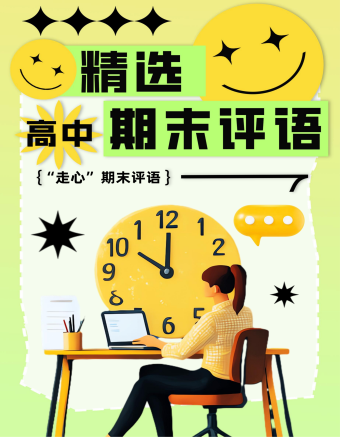
精选高中生期末评语
1、该生学习态度端正 ,能够积极配合老师 ,善于调动课堂气氛。 能够积极完成老师布置的任务。学习劲头足,听课又专注 ,做事更认 真 ,你是同学们学习的榜样。但是,成绩只代表昨天,并不能说明你 明天就一定也很优秀。所以,每个人都应该把成绩当作自己腾飞的起 点。2、 你不爱说话 ,但勤奋好学,诚实可爱;你做事踏实、认真、为 人忠厚 ,是一个品行端正、有上进心、有良好的道德修养的好学生。在学习上,积极、主动,能按时完成老师布置的作业,经过努力 ,各 科成绩都有明显进步,你有较强的思维能力和学习领悟力,学习也有 计划性,但在老师看来,你的潜力还没有完全发挥出来,学习上还要有持久的恒心和顽强的毅力。
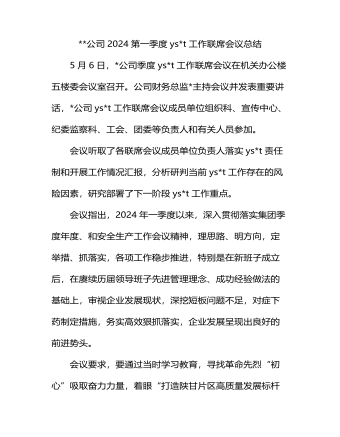
公司2024第一季度意识形态工作联席会议总结
一是要把好正确导向。严格落实主体责任,逐条逐项细化任务,层层传导压力。要抓实思想引领,把理论学习贯穿始终,全身心投入主题教育当中;把理论学习、调查研究、推动发展、检视整改等有机融合、一体推进;坚持学思用贯通、知信行统一,努力在以学铸魂、以学增智、以学正风、以学促干方面取得实实在在的成效。更加深刻领会到******主义思想的科学体系、核心要义、实践要求,进一步坚定了理想信念,锤炼了政治品格,增强了工作本领,要自觉运用的创新理论研究新情况、解决新问题,为西北矿业高质量发展作出贡献。二是要加强应急处事能力。认真组织开展好各类理论宣讲和文化活动,发挥好基层ys*t阵地作用,加强分析预警和应对处置能力,提高发现力、研判力、处置力,起到稳定和引导作用。要坚决唱响主旋律,为“打造陕甘片区高质量发展标杆矿井”、建设“七个一流”能源集团和“精优智特”新淄矿营造良好的舆论氛围。三是加强舆情的搜集及应对。加强职工群众热点问题的舆论引导,做好舆情的收集、分析和研判,把握时、度、效,重视网上和网下舆情应对。
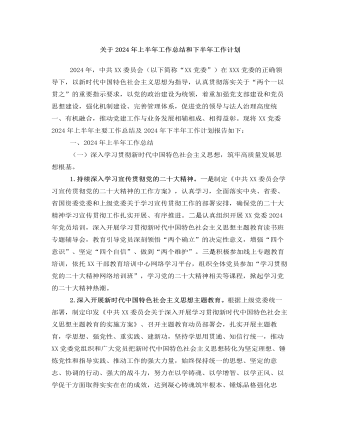
关于2024年上半年工作总结和下半年工作计划
二是深耕意识形态。加强意识形态、网络舆论阵地建设和管理,把握重大时间节点,科学分析研判意识形态领域情况,旗帜鲜明反对和抵制各种错误观点,有效防范处置风险隐患。积极响应和高效落实上级党委的决策部署,确保执行不偏向、不变通、不走样。(二)全面深化党的组织建设,锻造坚强有力的基层党组织。一是提高基层党组织建设力量。压实党建责任,从政治高度检视分析党建工作短板弱项,有针对性提出改进工作的思路和办法。持续优化党建考核评价体系。二是纵深推进基层党建,打造坚强战斗堡垒。创新实施党建工作模式,继续打造党建品牌,抓实“五强五化”党组织创建,广泛开展党员教育学习活动,以实际行动推动党建工作和经营发展目标同向、部署同步、工作同力。三是加强高素质专业化党员队伍管理。配齐配强支部党务工作者,把党务工作岗位作为培养锻炼干部的重要平台。
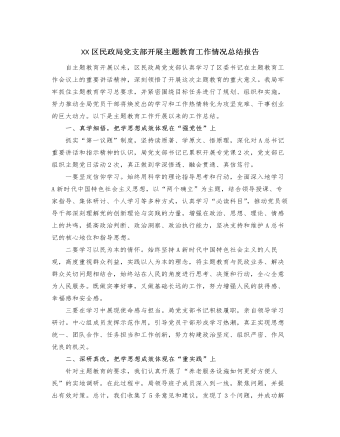
XX区民政局党支部开展主题教育工作情况总结报告
二要专注于解决问题。根据市委促进经济转型的总要求,聚焦“四个经济”和“双中心”的建设,深入了解基层科技工作、学术交流、组织建设等方面的实际情况,全面了解群众的真实需求,解决相关问题,并针对科技工作中存在的问题,采取实际措施,推动问题的实际解决。三要专注于急难愁盼问题。优化“民声热线”,推动解决一系列基层民生问题,努力将“民声热线”打造成主题教育的关键工具和展示平台。目前,“民声热线”已回应了群众的8个政策问题,并成功解决其中7个问题,真正使人民群众感受到了实质性的变化和效果。接下来,我局将继续深入学习主题教育的精神,借鉴其他单位的优秀经验和方法,以更高的要求、更严格的纪律、更实际的措施和更好的成果,不断深化主题教育的实施,展现新的风貌和活力。
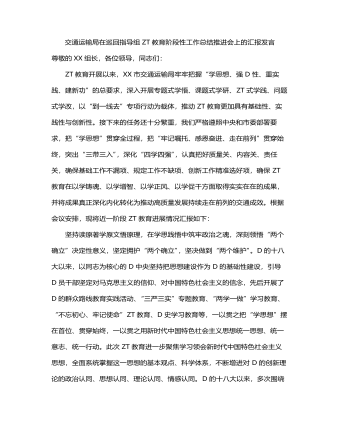
交通运输局在巡回指导组主题教育阶段性工作总结推进会上的汇报发言
今年3月,市政府出台《关于加快打造更具特色的“水运XX”的意见》,提出到2025年,“苏南运河全线达到准二级,实现2000吨级舶全天候畅行”。作为“水运XX”建设首战,谏壁闸一线闸扩容工程开工在即,但项目开工前还有许多实际问题亟需解决。结合“到一线去”专项行动,我们深入到谏壁闸一线,详细了解工程前期进展,实地察看谏壁闸周边环境和舶通航情况,不断完善施工设计方案。牢牢把握高质量发展这个首要任务,在学思践悟中开创建功之业,坚定扛起“走在前、挑大梁、多做贡献”的交通责任,奋力推动交通运输高质量发展持续走在前列。以学促干建新功,关键在推动高质量发展持续走在前列。新时代中国特色社会主义思想着重强调立足新发展阶段、贯彻新发展理念、构建新发展格局,推动高质量发展,提出了新发展阶段我国经济高质量发展要坚持的主线、重大战略目标、工作总基调和方法论等,深刻体现了这一思想的重要实践价值。
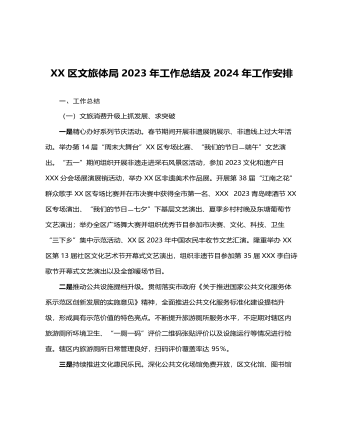
XX区文旅体局2023年工作总结 及2024年工作安排
三、2024年工作计划一是完善基层公共文化服务管理标准化模式,持续在公共文化服务精准化上探索创新,围绕群众需求,不断调整公共文化服务内容和形式,提升群众满意度。推进乡镇(街道)“114861”工程和农村文化“121616”工程,加大已开展活动的上传力度,确保年度目标任务按时保质保量完成。服务“双减”政策,持续做好校外培训机构审批工作,结合我区工作实际和文旅资源优势,进一步丰富我市义务教育阶段学生“双减”后的课外文化生活,推动“双减”政策走深走实。二是结合文旅产业融合发展示范区,全力推进全域旅游示范区创建,严格按照《国家全域旅游示范区验收标准》要求,极推动旅游产品全域布局、旅游要素全域配置、旅游设施全域优化、旅游产业全域覆盖。
今日更新Word
-

精选高中生期末评语
1、该生学习态度端正 ,能够积极配合老师 ,善于调动课堂气氛。 能够积极完成老师布置的任务。学习劲头足,听课又专注 ,做事更认 真 ,你是同学们学习的榜样。但是,成绩只代表昨天,并不能说明你 明天就一定也很优秀。所以,每个人都应该把成绩当作自己腾飞的起 点。2、 你不爱说话 ,但勤奋好学,诚实可爱;你做事踏实、认真、为 人忠厚 ,是一个品行端正、有上进心、有良好的道德修养的好学生。在学习上,积极、主动,能按时完成老师布置的作业,经过努力 ,各 科成绩都有明显进步,你有较强的思维能力和学习领悟力,学习也有 计划性,但在老师看来,你的潜力还没有完全发挥出来,学习上还要有持久的恒心和顽强的毅力。
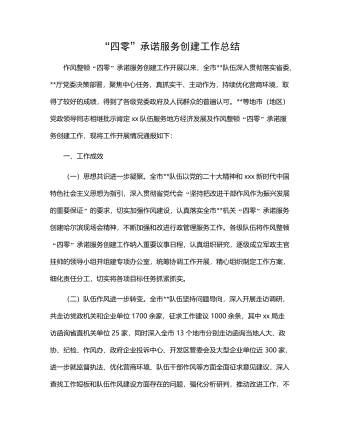
“四零”承诺服务创建工作总结
(二)坚持问题导向,持续改进工作。要继续在提高工作效率和服务质量上下功夫,积极学习借鉴其他部门及xx关于“四零”承诺服务创建工作的先进经验,同时主动查找并着力解决困扰企业和群众办事创业的难点问题。要进一步探索创新,继续优化工作流程,精简审批程序,缩短办事路径,压缩办理时限,深化政务公开,努力为企业当好“保姆”,为群众提供便利,不断适应新时代人民群众对政务服务的新需求。(三)深化内外宣传,树立良好形象。要深入挖掘并及时总结作风整顿“四零”承诺服务创建工作中形成的典型经验做法,进一步强化内部宣传与工作交流,推动全市创建工作质效整体提升。要面向社会和公众庄严承诺并积极践诺,主动接受监督,同时要依托电台、电视台、报纸及微信、微博等各类媒体大力宣传xx队伍作风整顿“四零”承诺服务创建工作成果,不断扩大社会知情面和群众知晓率。
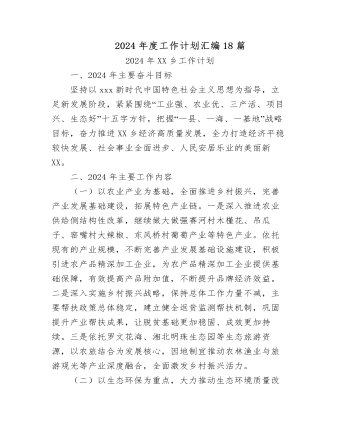
2024年度工作计划汇编(18篇)
1.市政基础设施项目5项,总建设里程2.13km,投资概算2.28亿元。其中,烔炀大道(涉铁)工程施工单位已进场,项目部基本建成,正在办理临时用地、用电及用水等相关工作;中铁佰和佰乐(巢湖)二期10KV外线工程已签订施工合同;黄麓镇健康路、纬四路新建工程均已完成清单初稿编制,亟需黄麓镇完成图审工作和健康路新建工程的前期证件办理;公安学院配套道路项目在黄麓镇完成围墙建设后即可进场施工。2.公益性建设项目6项,总建筑面积15.62万㎡,投资概算10.41亿元。其中,居巢区职业教育中心新建工程、巢湖市世纪新都小学扩建工程已完成施工、监理招标挂网,2月上旬完成全部招标工作;合肥职业技术学院大维修三期已完成招标工作,近期签订施工合同后组织进场施工;半汤疗养院净化和医用气体工程已完成招标工作;半汤疗养院智能化工程因投诉暂时中止;巢湖市中医院(中西医结合医院)新建工程正在按照既定计划推进,预计4月中下旬挂网招标。

驻村工作队2024年第一季度工作总结汇编(4篇)
三是做大做强海产品自主品牌。工作队于xx年指导成立的冬松村海产品合作社,通过与消费帮扶平台合作,在工作队各派出单位、社会团体、个人支持下,已获得逾xx万元销售额。2022年底工作队推动合作社海产品加工点扩建的工作方案已获批,待资金下拨后将正式启动扩建工作。四是积极助企纾困,带动群众增收致富。工作队利用去年建立的xx镇产业发展工作群,收集本地企业在产品销售、技术、人力、资金、运营、用地等方面的需求,并加大xx支持乡村振兴力度,xx助理赴各村委开展多场xx政策支持乡村振兴宣讲活动,本季度有x万元助农贷款获批,xx万贷款正在审批中。在壮大既有产业的同时,完善联农带农机制,一方面鼓励企业雇用本地农户就业,另一方面计划与本地农户签订长期收购合同,让农民种得放心、种得安心,带动当地群众共同致富。

主题教育总结常用提纲大全
第一,主题教育是一次思想作风的深刻洗礼,初心传统进一步得到回归。第二,主题教育是一次沉疴积弊的集中清扫,突出问题进一步得到整治。第三,主题教育是一次强化为民服务的生动实践,赤子之情进一步得到提振。第四,主题教育是一次激发创业担当的有利契机,发展层次进一步得到提升。2.第一,必须提领思想、武装思想。第二,必须聚焦问题、由表及里。第三,必须领导带头、以上率下。第四,必须务实求实、认真较真。3.一是抬高政治站位,坚持大事大抓。二是坚持思想领先,狠抓学习教育。三是突出问题导向,深入整改纠治。四是坚持领导带头,发挥表率作用。4.一是立足“早”字抓筹划。二是着眼“活”字抓学习。三是围绕“统”字抓协调。5.一是形势所需。二是任务所系。三是职责所在。四是制度所定。6.一要提升认识。二要积极作为。三要密切协作。
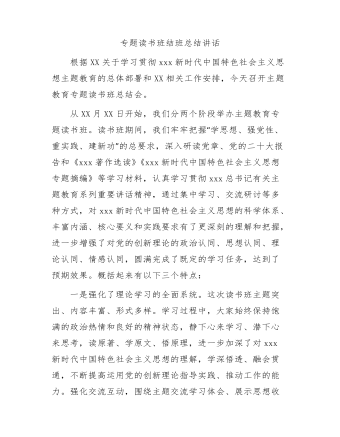
主题教育专题读书班结班总结讲话
第二,要把调查研究贯穿始终,实干担当促进发展。开展好“察实情、出实招”“破难题、促发展”“办实事、解民忧”专项行动,以强化理论学习指导发展实践,以深化调查研究推动解决发展难题。领导班子成员要每人牵头XX个课题开展调查研究,XX月底前召开调研成果交流会,集思广益研究对策措施。各部门、各单位要制定调研计划,通过座谈访谈、问卷调查、统计分析等方式开展调查研究,解决工作实际问题,帮助基层单位和客户解决实际困难。第三,要把检视问题贯穿始终,廉洁奉公树立新风。认真落实公司主题教育整改整治工作方案要求,坚持边学习、边对照、边检视、边整改,对标对表xxx新时代中国特色社会主义思想,深入查摆不足,系统梳理调查研究发现的问题、推动发展遇到的问题、群众反映强烈的问题,结合巡视巡察、审计和内外部监督检查发现的问题,形成问题清单。

















